I am beginning the writing of this on Saturday, December 8, around 11:30PM. A week ago & a few hours earlier, I was agitating over six lead changes as I watched Bama ultimately beat Georgia in the SEC college football championship, but I was wondering why I wasn’t seeing messages on Facebook from my old friend Brent, who has long been a huge football fan. I have known Brent for 27 years, since we were 14 years old, & he has always followed football. I couldn’t be bothered to care about any sports, much less football, until I moved to Alabama a few years ago, & he found my sudden & gluttonous conversion amusing, posting “Roll Tide” or jabs on my Facebook wall from his apartment in Boise, Idaho whenever the Tide stumbled. But last week, unbeknownst to me at the time, he was dying as I was watching the game, probably passing around the time the game ended, while I was jumping up & down in a friend’s living room cheering. I’ve just been turning this over & over in my mind for the past week, along with every other detail of his life that I remember & my own emotional pique.
I want to write around Brent, as a way to process his death, & because I think it’s relevant, though I don’t know precisely why. I think I need to do this because we were once best friends, & I think it’s important to invoke him as an integral influence on my life. We wrote for the high school newspaper together. We came of age together. I followed him to New York City. We started a band together. We were roommates, co-workers, brothers-in-arms. He was among the people I’ve been closest to in my life. He remembered things about me that even I don’t know or had forgotten; & so with his death a part of me has died, & it feels that way. So I need to do something commemorative & integrative with what there is of him that is still with me. I’ll start with how he died & what we celebrated together when we were young.

Ravin’ & His Morning Shakes: In digging thru old photos this past week, I found this old live shot that I like of the Morning Shakes in our prime (that’s Brent in the middle singing, me in the background in the yellow shirt, Jose in the foreground, & our drummer Scott is out of the picture)
Brent died of internal hemoraging brought on by alcohol toxicity, from what I understand. This is not a surprise, though I am stunned by it, because I still didn’t think it would happen, despite so many of my memories being of how we burned candles from both ends & the middle. Our earliest bonding was over writers like Charles Bukowski. For a time, we did nothing if not romanticize alcohol, though it didn’t start that way. I didn’t start drinking until I was in college, but then I went at it hard, & later on Brent & I started a band (with Jose, who went to college with Brent) called The Morning Shakes with songs like “Blind Drunk” (chronicling a true story of being arrested & beat up in the drunk tank), “(Buy a Drink for) Charles Bukowski,” & “All Fucked Up.” Certainly not original but you see the theme. Yet when I reflect on things, I think Brent had been drinking since I knew him. He’d been drinking since before he was 14. And among those of us in the band for whom hard drinking was not merely a stage schtick, only Brent did not slow down or stop altogether. Why he could not stop & why he ultimately let it destroy him is what I find myself anguishing over. In life, Brent had as much opportunity & privilege as any of the rest of us, & so what could have led to an untimely alcohol-related death at the young age of 41 (he would have been 42 on December 21, just a few days from now) is a bit of a mystery.
One thing to which alcoholism has been linked is a genetic predisposition, which I want to consider. I don’t know anything about Brent’s genes or possible family history of alcoholism, so I am not supposing what I’m going to discuss has any relation to Brent in reality. But it might. In this post that is around Brent & what Brent is now leading me to think about, I want to consider the link between the 5-HTT gene-linked polymorphic region (LPR) for the serotonin transporter, the association with the short-allele of that polymorphism with alcoholism, & how this short allele could have evolved.
Serotonin
Serotonin is a neurotransmitter also known as 5-hydroxytryptamine (5-HT). It is derived from tryptophan, one of the essential amino acids that we get from outside our body (& the culprit blamed for making us sleepy after eating too much turkey on Thanksgiving, which probably has more to do with all the carbs & absolute volume we consume in one sitting, as turkey has no more tryptophan than other meats). The levels of serotonin in our bodies are therefore dependent, to some extent, on our diet. About 10% of the serotonin activity in our bodies is related to mood, appetite, and sleep regulation. It has come to be associated largely with well-being and happiness as a result, though, ironically, 90% of its activity is related to the regulation of intestinal movement and other roles. It seems to have a role in expulsion & diarrhea, as it is present in many seeds & may stimulate the digestive tracts of ingesting animals to expel them.
Ironic or not, that 10% is tremendously influential on the massively integrated supercomputer that is our brain. What it seems to do is tone down our amygdalar fear response. The amygdala seems to be the brain region responsible for our experience of fear, but it is functionally connected to the cingulate cortex, which dampens this fear response when, for instance, we rationally know there is really nothing to fear or that our experience of fear won’t actually help us. In our brain, serotonin is regulated not just by the absolute amount released by pre-synaptic nerve cells into synapses to be taken up by post-synaptic nerve cells, but by the amount & time that it is allowed to remain there. To gloss the process somewhat, there are a limited number of serotonin receptors on a post-synaptic nerve cell, & the serotonin that doesn’t get immediately taken up does not get to merely wait around in the synaptic cleft for the next bus–they must now go to the back of the line (unfair though that may seem). Specialized transporters (the 2nd “T” in 5-HTT) catch them wandering around in the cleft & drag them back to the pre-synaptic cell to be recycled. There are multiple transporters, however–like having multiple privatized companies competing on the same job–& they are not uniformly efficient at their tasks. Some of them have high affinity (SERT) for serotonin & are like magnets that easily grab them one at a time, while others have less affinity (PMAT) but more carrying capacity (like a pickup truck). Our genes for 5-HTT & to some extent psychopharmaceuticals like SSRIs (selective serotonin reuptake inhibitors) regulate this transporter efficiency &, thus, the serotonin levels in our brains (SSRIs have limited influence on PMAT, it turns out).
5-HTT Gene-Linked Polymorphic Region
There are numerous polymorphisms for the genes controlling the production of these proteins that transport serotonin. The gene that codes for SERT in humans is SLC6A4 (solute carrier family 6 for serotonin transport, member 4) on chromosome 17, & ~50 polymorphisms have been associated with it. Among them are single nucleotide polymorphisms (SNPs) with varying numbers of repeated sequences in the promoter region, resulting in “short” (14 repeats) & “long” (16 repeats) SNPs. What this means is that short SNPs result in less efficient transcription of the gene & therefore less of the protein (the transporter) produced. Long (L) and short (S) seem to be co-dominant, so individuals can have LL, LS, or SS genotypes, which translate into higher production of SERT (LL), medium production (LS), or lower production (SS). With lower production of SERT, serotonin will stay in the synapse longer. Ironically (more damned irony?–meaning, we don’t fully understand these things & keep oversimplifying them), lower SERT has actually been associated with lower resilience to anxiety & stress. S-allele carriers (i.e., both LS & SS genotypes) are associated with reduced amygdala/cingulate cortex functional connectivity relative to the LL genotype. It is the connectivity & a robust feedback between these two brain regions that mediates fear response & enables us to dampen it when unnecessary or inappropriate. Serotonin plays a role in this connectivity, but it is not simply like watering a plant to make it live, as too much serotonin is what is associated with risk for mood disorder. This seems paradoxical, but the reality is that SERT plays a more complex role in an epigenetic system & cannot be assessed based on unitary models of absolute levels. The psychobiological influence of these genotypes seems to be laid down during development, such that less serotonin is called for early in life to develop robust amygdala/cingulate cortex functional connectivity, but more serotonin is called for later to alleviate the symptoms of mood disorder.
However wrong it may be to emphasize absolutes, I’m going to review the relationship of absolute levels based on the simplified model of 5-HTT as the vulnerability gene & the relationship to alcoholism before backtracking a little & considering the more complex &, NOT ironically, more realistic picture of SERT in context.
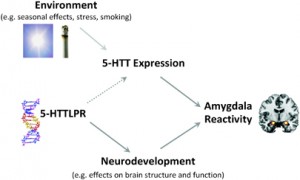
Association between 5-HTTLPR, 5-HTT availability, & amygdala reactivity (Source: Kobiella et al. 2011).
SERT & Alcoholism
Studies of rhesus monkeys indicate differences in temperament among individuals from birth that may be related to SERT genes. Approximately 20% of rhesus infants are jumpy, reacting with high levels of stress or anxiety to mildly novel situations & displaying chronically elevated “stress” hormone (cortisol). These fearful infants tend to show deviations from species-normal play behavior at 6 months as well, being more reticent to separate from their mothers to play with peers, engaging in less peer-play, & displaying higher cortisol during play-separation, which is indicative of anxiety. Another 5-10% of the rhesus infants display impulsive or inappropriately aggressive behavior & have low cerebrospinal serotonin &, at 6 months, continue to display inappropriate behaviors among peers, who then tend to avoid them. Peer-play is critical to social learning, & therefore these monkeys do not learn to moderate their overly aggressive behaviors. In these monkeys, levels of aggression correlate inversely with serotonin, such that the most aggressive individuals have the lowest serotonin levels. Significantly, both the fearful & the aggressive subgroups are associated with higher levels of alcohol consumption at 5 years of age when placed in “happy hour” situations (don’t ask) than age-matched normal monkeys, which show more moderate drinking behavior.
 Big deal. These are monkeys, right? Does that mean that because we’re all primates, we have the exact same endocrine relationships with anxiety, alcohol, & whatnot? Of course not. But macaques (& other cercopithecines, like baboons) are great analogs to humans. Among primates, they are most similar to humans in possessing a generic mammalian anatomy & physiology with the flexibility to survive almost anywhere on the planet, despite changing ecosystems. While great ape populations plummet, macaques & baboons thrive, subsisting in overlapping distributions with humans, eating our garbage, raiding our crops (& homes), residing in snowy regions, mountainous regions, arid regions, tropical island regions, etc., just like us. As Robert Sapolsky has effectively demonstrated, the psychosocial dynamics of group living have implications on endocrine profiles in ways remarkably similar to those of humans. Rhesus macaques & humans in particular are unique among primates as “weed” species, meaning we are among the most successful primate species, flourishing everywhere our populations are seeded & outcompeting other species in the ecosystem. Furthermore, rhesus macaques have essentially the same 5-HTT polymorphism as humans. But here’s the crazy part–in a comparison of six macaque species with the 5-HTT gene, NONE of the others had this same SNP, though some had extra-long or extra-short repeats. Not surprisingly, these lengths were associated with aggression in the species.
Big deal. These are monkeys, right? Does that mean that because we’re all primates, we have the exact same endocrine relationships with anxiety, alcohol, & whatnot? Of course not. But macaques (& other cercopithecines, like baboons) are great analogs to humans. Among primates, they are most similar to humans in possessing a generic mammalian anatomy & physiology with the flexibility to survive almost anywhere on the planet, despite changing ecosystems. While great ape populations plummet, macaques & baboons thrive, subsisting in overlapping distributions with humans, eating our garbage, raiding our crops (& homes), residing in snowy regions, mountainous regions, arid regions, tropical island regions, etc., just like us. As Robert Sapolsky has effectively demonstrated, the psychosocial dynamics of group living have implications on endocrine profiles in ways remarkably similar to those of humans. Rhesus macaques & humans in particular are unique among primates as “weed” species, meaning we are among the most successful primate species, flourishing everywhere our populations are seeded & outcompeting other species in the ecosystem. Furthermore, rhesus macaques have essentially the same 5-HTT polymorphism as humans. But here’s the crazy part–in a comparison of six macaque species with the 5-HTT gene, NONE of the others had this same SNP, though some had extra-long or extra-short repeats. Not surprisingly, these lengths were associated with aggression in the species.
So what does this suggest? That all the people who stay past happy hour & don’t know when to stop drinking & go home were anxious or aggressive infants? Not so fast. Some anxious & some aggressive people are not necessarily depressed, do not necessarily have drinking problems, & some “normal” people are lushes. What about hardship, lost jobs, mean parents, getting dumped & crapped on, & all those other things that drive a person to drink? Well, again, not every barfly had a miserable upbringing or lost his/her job & not every hardship case is a binge drinker. In some studies, depression, anxiety, alcohol dependence, & other mood disorders have been associated with the short SERT allele when developmental environments (e.g., childhood) are marked by trauma or unstable maternal attachment. Thus, it believed there is a gene-by-environment (GxE) interaction that predicts mood disorders & alcohol dependence. For instance, in studies of rhesus monkeys raised with birth mothers & peers (MP) or peers only (PO), PO monkeys with the short allele display more aggressive behavior as infants & adolescents & alcoholic-type behavior as adults. Short-allele MP monkeys behave normally, as do MP & PO long-allele monkeys.
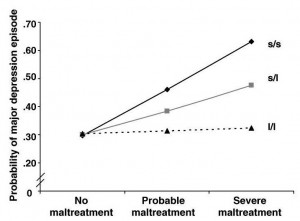
Association between childhood maltreatment & adult depression as a function of 5-HTT genotype (Source: Caspi et al. 2003).
Similar relationships have been found in humans based on statistical correlations. These associations have been interpreted variously as a “good” gene (long allele) providing protection against a “bad” environment or that good maternal care “buffers” against the disadvantage of a “bad” gene (short allele). There are a few problems with this model. The first is that studies of these associations are not consistent. In other words, I’m giving you a gloss that is not always true, but it does make for a nice ‘just so’ story. Second, because it’s so tidy, there’s always a suspicion of data being favored when they support such models & the careers they blossom–i.e., if you have a candidate gene in mind for explaining mood disorders & are writing grant proposals to continue studying said gene, it’s good to have some findings to support your hypothesis. It is for this reason that others suggest whole genome studies are a better way to go, in addition to the fact that mood disorders are not just purely GxE-oriented but also polygenic in nature (Remember PMAT? Might a PO-reared individual with the short allele still end up normal because of higher proportion of PMAT to SERT?). The SERT gene may be a red herring altogether, exerting a relatively small effect across a large number of implicated mood disorders, while rare allelic variants difficult to pinpoint may play larger & relatively idiopathic roles. Third, not all primates have the 5-HTT polymorphism the way rhesus macaques & humans have it. We are not descended from macaques, as many of you know; rhesus macaques & humans evolved independent of each other, yet developed similar systems. Why would that be? It suggests that the 5-HTTLPR does not involve a “good” or “bad” allele but ecologically relative variation that has been selected for more than once in similar species. Why might the short allele have been naturally selected?
Finally, these models don’t describe my friend. I don’t know his 5-HTT genotype, but he didn’t suffer a traumatic childhood that I know of. His parents are still married, happily to my knowledge; his father was a well-to-do doctor before retiring, & Brent grew up with plenty of parental interest & care. His father was a little tough on him according to his complaints 20 years ago (&, admittedly, we friends of Brent were all a little afraid of him back then) but not in any way I would consider remotely traumatic. And Brent had a quintessential “maternal buffer,” as his mother has always been warm, affectionate, & open-minded & very much doted on him. So why did my friend persist in self-destructive alcoholism while the rest of us suburban white kids with similar middle-class backgrounds who played with the same fire more or less did not?
Evolution of the Short Allele
A model that makes more sense from an evolutionary perspective frames these polymorphisms in terms of ecological variability. The “orchid-dandelion hypothesis” for the SERT & other polymorphisms related to mood (aka, the “sensitivity hypothesis”) suggests that some people are like dandelions & do about the same anywhere regardless of their circumstances, whereas others are sensitive like orchids & excel under good circumstances but fare poorly in bad conditions. One implication of this model is that “orchid” genes are adaptive in influencing heightened attention & deeper understanding. For instance, what looks like anxiety in the infants might be interpreted as deep observation & taking things in.

(a) Color map of frequency distribution of individualism-collectivism. (b) Frequency distribution of S alleles. Source: Chiao & Blizinsky (2010)
An adaptation model makes sense given emerging evidence that human evolution has picked up pace in the past 50-100,000, rather than slowing down as generally conceived. One of the reasons for the rapid cultural & probably genetic evolution during this period has been the achievement of a human population size capable of sustaining genetic variants. The chances of even beneficial traits being passed on are very slim when population sizes are small & gene flow minimal. The short SERT & other orchid-gene variants did not exist in human populations before 80,000 years ago but have now spread into 20-35% of the population. The advantage to a population in this model is that there are people who get things done no matter what (dandelions), but there are also more dynamic variants (orchids) who may contribute the sensation-seeking & risk-taking we associate with creativity.
Yet not all human populations are monolithic in these regards, & the SERT polymorphism is not uniformly distributed. Of the regions where data on 5-HTT variation are available (this is limited), we see higher rates of the short allele around the equator (such as in East Asia, where S-allele rates are as high as 70-80%) & lower rates away from it (such as in Europe, where rates average 40-45%). In contrast, we see higher rates of mood disorders generally associated with orchid-gene variants (such as the 5-HTT S-allele) in regions where the rates of these alleles are actually lower & lower rates of mood disorders in higher orchid-gene regions like East Asia. One explanation for this seeming contradiction is invoked using the parasite-driven wedge model (aka, the behavioral immune system), which suggests gene-culture co-evolution is the result of ecologically relative pathogen biodiversity. Group-oriented collectivism may be an adaptive strategy where pathogen biodiversity is higher & individualism an adaptive strategy where it is lower. Collectivism would also buffer against chronic life stress, to which S-allele carriers would be at higher risk in individualistic cultures. Preliminary analyses suggest that short allele distributions of the SERT polymorphism do indeed correlate with individualism-collectivism.
Remembrance

The Morning Shakes broke up in 2000, but we started getting back together with our friends & family around 2006 (dubbed “Rock’n’Roll Picnics”). Here we are in New Paltz, NY that year amidst all our old friends & growing families. Brent is 3rd from the left wearing the red shirt.
I don’t buy the vulnerability-gene model. Perhaps you got that impression. I don’t buy it because I don’t want it to be the explanation for my friend & because I don’t think it fits. He was a sensitive, dynamic guy who violated social boundaries, sometimes without caring & other times without even realizing it. In middle school he got in trouble for bringing a witchcraft book to school & got marked as a weirdo putting spells on people, which I think he embraced. In high school, it was the Anarchist Cookbook that he brought in to mess with people’s mind, but he was far from a trenchcoated sociopath (though I seem to recall a trenchcoat). Brent had a sense of fairness & morality that far exceeded my own. He was a defender of the downtrodden & oddball, where I might have been snide, critical, or condescending. When we lived together in Brooklyn, he would bring homeless artist types he met in bars back to our apartment for a night’s sleep, a joint, some handrolled cigarettes, & hits of cheap booze. Yet as an adult, he himself rarely had more than a few CDs, his books, some athletic-team jerseys, & whatever he was carrying around in a plastic bag to his name. He lived a decidedly bohemian life with absolutely none of the bohemian pretentions. It was my growing irritation with his stubborn, opinionated inelegance that resulted in the major rupture in our friendship. We’d been together so long that I had accumulated a satchel of resentments, & they exploded one night outside the Clermont Lounge in Atlanta while on the ‘Shakes second tour. We didn’t speak for a few years, & he wasn’t invited to my wedding, which I regret. When he first landed in the hospital a few years later, due to alcohol-related health problems, & then did his first stint in rehab, I finally put aside my petty grievances by writing him a letter to tell him how important he was to me (he wasn’t allowed phone access at the time). We were reconciled thereafter but had moved in different directions. I was married with children & going to grad school in upstate NY & later moved to Alabama. He was still in NY until last year, struggling to make ends meet, struggling with addiction. We did have one last hurrah. The band reunited in the summer of 2011 & had probably our best (& soberest) show ever, though it was in fact almost marred by a relapse & hospitalization Brent had just a month beforehand. Despite all the problems I knew he was having, Brent was as smart & perceptive as ever. We fell right back into the old groove, competing intellectually, butting heads about how best to showcase our collaborative “art,” & feeling awesomely full of ourselves.
This riffing around my friend & attempt to process what pisses me off about his leaving us is not meant to reduce Brent to a scientific model, but if theory can shed any light on his trouble, I think the orchid model comes the closest. Brent was sensitive & attentive. I think sensitivity is like a magnet for all the world has to offer, the wonderfulness, the wretchedness, & everything in between; & that makes life dangerous when one purposefully avoids the middle road for, cliche though it may be, the road less traveled. I think many tragic cultural icons (Vincent van Gogh or Jack Kerouac come to mind) are iconic & tragic specifically because they are like orchids, a precarious balance of oppositions, or maybe because we value the rugged individualism that leaves them dangling out in the cultural slipstream, flying fast & high but subject to long falls or jet blasts. Brent would talk to anyone, & one of my favorite memories of his magnetic perceptivity was of a short story he wrote about a homeless man called “Big Pinky.” Brent’s sensitivity to others’ troubles & ability to empathize without romanticizing, simply & eloquently portraying this man & his fondness for pink hygiene products was a creative talent I envied.
Brent might have liked being compared to orchids for these reasons. Then again, he might’ve found it embarrassing & thought I had the whole thing dead wrong. Who the hell knows? I wish he was still out there, & he could tell me himself. I’d be glad to have an argument about it.
References & Sources
CASPI, A., et al. (2003) Influence of Life Stress on Depression: Moderation by a Polymorphism in the 5-HTT Gene. Science, 301: 386-389.
DOBBS, D. (2012) Can Genes Send You High or Low? The Orchid Hypothesis A-Bloom. Neuron Culture.
MUNAFO, M.R. (2012) The Serotonin Transporter Gene and Depression. Depress Anxiety, 29: 915-917.
http://www.bio.davidson.edu/courses/genomics/2003/mccord/5-htt.html
http://www.psycheducation.org/mechanism/4WhyShortsLongs.htm
http://en.wikipedia.org/wiki/Serotonin
http://en.wikipedia.org/wiki/Serotonin_transporter
Acknowledgements:
Thanks to several friends & others I who helped me on Facebook, in the Neuroanthropology Interest Group, & in person with the neuroscience & my flawed memory, including Brandon Unroe, Jason DeCaro, Hadley Wilson-Horch, John Hawks, Melanie Shoup-Knox, Daniel Lende, Lori Hogenkamp, & Caitlin Aamodt.


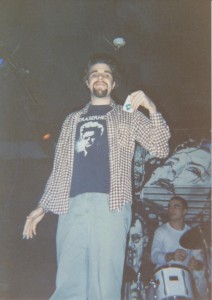
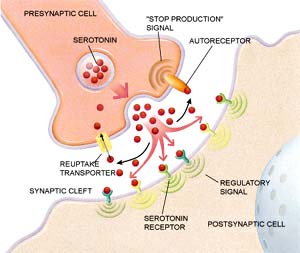
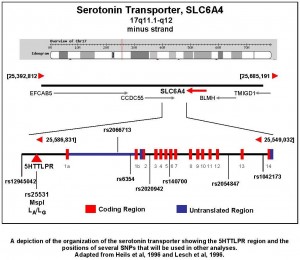
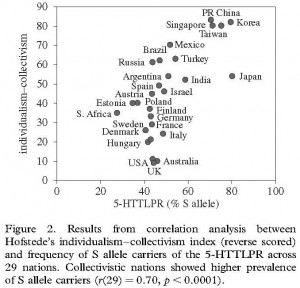

Pingback: Of Epigenetic Aggression & Silver Foxes | Welcome to the EvoS Consortium!
Hey Alex,
I remembered that I’d received a message from you, but forgot where it was. Apologies. His parents are holding a memorial on Memorial Day at their house in Indy. I know it’s short notice, but you can find the details here: https://www.facebook.com/events/523678681002589/?ref=2
Hey Chritopher,
My name is Alex Stollenwerck and I just found out that Brent passed away and I am very sad to hear the news. I went to Manhattanville College with him and we were very good friends. We definitely shared our love for alcohol, loose women, music, books, art, etc…I really liked what you wrote. It brought back memories but also sadness to know that he is no longer around. Brent was a really special person and the world will not be the same without him. Take care!